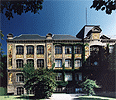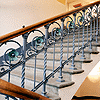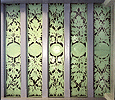The
Ecole des Arts Décoratifs(1) was founded in 1890 by the City of Strasbourg in order to foster the artistic revival in the region
(2).
The painter Anton Seder (from Munich) become director. The city decided in April 1892 to build new premises, functional and with a plain design, at the 1, rue de l'Académie, where the botanical garden was formerly located.
This school, erected by the city's chief architect Johann Ott (assisted by Roederer and Herrmann), has been achieved at Easter 1892. The façade, made of yellow brick, is fitted with large windows and tile panels whose decor has been conceived by Seder and achieved in 1892-93 by Leon Echinger (in Soufflenheim, Alsace) a former pupil who became famous with his art nouveau and art deco creations
(3). The iconography evokes, through allegories, the matters teached there: Architecture, Painting, and Sculpture (held as fine arts) and founded on the knowledge of Science, Archeology and Geometry. The central fore-part, stamped by historicism, shows also great tile panels. At left, an allegory of Strasbourg, at right that one of Alsace. The upper fronton is inspired by the magazine
Das Kunstgewerbe in Elsass-Lothringen(4) (co-edited by Seder), meanwhile the lower panels are dedicated to the decorative arts. The breast-walls witness a less academic treatment, offer a naturalistic decor, evidencing the first fruits of art nouveau, and rendering the principles teached by Seder, who gave his fame to the school
(5).
From the inner decoration, only a little remains: an iron hand-rail with a floral decor, ceiling panels with a sunflower pattern, and a interesting door with an impressive frame made of polychromatic majolica which we may dare to qualify as being influenced by the ancient Egypt.
The items produced by the cabinet-maker's and the wrought-iron workshops were of great quality, but most of them disappeared during the nazi period.
As a conclusion, this building plays the part of a precursor in two ways:
First, by its plain façade and functional architecture that partly comes away from eclecticism;
Second, with its art nouveau decor, it announces the forthcoming artistic overturning.
(1) School of decorative arts
(2) Because of the lack of such a school until now, the future artists made their education in Dusseldorf, Karlsruhe, Munich or Stuttgart.
(3) See "Léon Elchinger", exhibition catalogue, Haguenau, 1992, and the Historic Museum at Haguenau (Alsace) that owns an interesting standing collection about this artist.
(4) The decorative arts in Alsace-Lorraine.
(5) Many famous artists become educated in that school. Among them, the sculptor Rupert Carabin (who succeeded Seder in 1920), Cammissar and Braunagel (famous fot their stained glass windows), and more recently Jean Arp and Thierry Mugler.
Bibliography
- Web site of the Ecole Supérieure des Arts Décoratifs
- CASSIR M.-C. L'Ecole des Arts Décoratifs de Strasbourg de 1890-1914: l'institution sous l'égide professeur Anton Seder, Master dissertation, Strasbourg, 1990
- CASSIR M.-C. L'Ecole des Arts Décoratifs de Strasbourg de 1890-1914: l'institution sous l'égide professeur Anton Seder, in Annuaire de la Société des Amis du Vieux Strasbourg, pp.134, Strasbourg, 1991
- DERNIERES NOUVELLES D'ALSACE Strasbourg en 1892, Strasbourg, 28 janvier 1992.
- HARSTER D. Ecole Municipale des Arts des Décoratifs, Dossier IVSMH du 18 décembre 1981
- TOUT LE BAS-RHIN pp.8-9, no7, septembre-octobre 2000
- Les Arts Décoratifs in Vivre à Strasbourg, pp. 15-26, no8, septembre 1983












